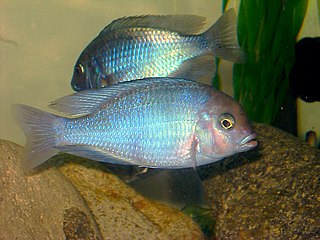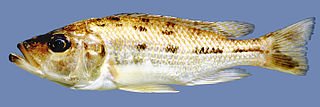
Cichlids are fish from the family Cichlidae in the order Cichliformes. Traditionally Cichlids were classed in a suborder, the Labroidei, along with the wrasses (Labridae), in the order Perciformes, but molecular studies have contradicted this grouping. On the basis of fossil evidence, it first appeared in Tanzania during the Eocene epoch, about 46–45 million years ago. The closest living relative of cichlids is probably the convict blenny, and both families are classified in the 5th edition of Fishes of the World as the two families in the Cichliformes, part of the subseries Ovalentaria. This family is large, diverse, and widely dispersed. At least 1,650 species have been scientifically described, making it one of the largest vertebrate families. New species are discovered annually, and many species remain undescribed. The actual number of species is therefore unknown, with estimates varying between 2,000 and 3,000.

Lake Malawi, also known as Lake Nyasa in Tanzania and Lago Niassa in Mozambique, is an African Great Lake and the southernmost lake in the East African Rift system, located between Malawi, Mozambique and Tanzania.

Mbuna is the common name for a large group of African cichlids from Lake Malawi, and are members of the haplochromine family. The name mbuna means "rockfish" in the language of the Tonga people of Malawi. As the name implies, most mbuna are cichlids that live among the piles of rocks and along the rocky shores of Lake Malawi, as opposed to the utaka, cichlids that live in the open water or on sandy shores or soft substrates. Some species of mbuna are highly sexually dimorphic, although many are not. Almost all of the cichlid species of Lake Malawi, including mbuna and non mbuna such as the utaka, are believed to have descended from one or a very few species that became isolated in the lake. With rising water levels, new habitats could be colonized and the many isolated rocky outcrops allowed new mbuna species to form. Their striking colors, intriguing behavioral characteristics, and relative hardiness make them very popular despite their unique demands for the home aquarist.

Pseudotropheus is a genus of fishes in the family Cichlidae. These mbuna cichlids are endemic to Lake Malawi in Eastern Africa.

Aulonocara is a genus of haplochromine cichlids endemic to Lake Malawi in East Africa. All Aulonocara species are maternal mouth brooders. Particularly in the aquarium hobby, Aulonocara species are also known as peacock cichlids, aulonocaras or simply "peacocks". This genus is strongly sexually dichromic, even by haplochromine standards.

Maylandia or Metriaclima is a genus of haplochromine cichlids endemic to Lake Malawi in East Africa. They belong to the mbuna (rock-dwelling) haplochromines.

Melanochromis is a genus of haplochromine cichlids endemic to Lake Malawi in Eastern Africa. Ecologically, they belong to the rock-dwelling mbuna cichlids of Lake Malawi.
Ethelwynn Trewavas was an ichthyologist at the British Museum of Natural History. She was known for her work on the families Cichlidae and Sciaenidae. She worked with Charles Tate Regan, another ichthyologist and taxonomist.

Protomelas is a genus of haplochromine cichlids endemic to Lake Malawi in East Africa. The genus is part of the haplochromine tribe and have maternal mouthbrooding and sexual dimorphism typical of this group. Popular in the aquarium hobby, Protomelas species are sold under a variety of trade names.

Corematodus is a small genus of haplochromine cichlids native to the Lake Malawi basin in Africa. They feed on scales and fins of other cichlids.
Labeotropheus is a genus of fish in the family Cichlidae endemic to Lake Malawi in eastern Africa. It includes at least 11 species, each with a number of subspecies or races. Further taxonomic work is required to determine how many species exist. These cichlids are popular ornamental fish and are ideally suited to the cichlid aquarium. Like many Malawi cichlids, these species are algal grazers. Like all cichlids from Lake Malawi these cichlids are best maintained in hard, alkaline water. This genus are best kept in aquariums with volumes greater than 120 L. The aquarium should be decorated with rocks, although caves can also be easily created from terracotta pots.

Sciaenochromis is a genus of haplochromine cichlids endemic to Lake Malawi in East Africa. The species are popular in the aquarium hobby, most notably S. fryeri.

Iodotropheus is a small genus of cichlids endemic to Lake Malawi in east Africa. The genus is distinguished from other genera of mbuna by the upper lip which is usually connected medially to the skin of the snout by a frenum; by its small, terminal mouth; by the outer teeth of both jaws, which are unequally bicuspid and loosely spaced, the tooth shafts inclined slightly toward the jaw symphysis; by the anterior teeth of the upper jaw being much longer and more robust than the lateral and posterior teeth. The rusty cichlid or lavender mbuna, Iodotropheus sprengerae is the most commonly encountered member of the genus in the aquarium trade.

The haplochromine cichlids are a tribe of cichlids in subfamily Pseudocrenilabrinae called Haplochromini. This group includes the type genus (Haplochromis) plus a number of closely related genera such as Aulonocara, Astatotilapia, and Chilotilapia. They are endemic to eastern, southern and northern Africa, except for Astatotilapia flaviijosephi in the Middle East. A common name in a scientific context is East African cichlids – while they are not restricted to that region, they are the dominant Cichlidae there. This tribe was extensively studied by Ethelwynn Trewavas, who made major reviews in 1935 and 1989, at the beginning and at the end of her career in ichthyology. Even today, numerous new species are being described each year.

Cyrtocara moorii, commonly known as the hump-head, is a species of haplochromine cichlid endemic to Lake Malawi in east Africa where they prefer areas with sandy substrates. It can grow to a length of 20 centimetres (7.9 in) TL. The species is popular among aquarium keepers where it is known as the hump-head cichlid, blue dolphin cichlid, Malawi dolphin or simply as moorii. It is currently the only known member of its genus. The specific name honours the English cytologist and biologist John Edmund Sharrock Moore (1870-1947).

Paedophagy in its general form is the feeding behaviour of fish or other animals whose diet is partially, or primarily the eggs or larvae of other animals. However, P. H. Greenwood, who was the first to describe paedophagia, defines it to be a feeding behaviour evolved among cichlid fishes.

Rhamphochromis is a genus of East African haplochromine cichlids endemic to the Lake Malawi basin, also including Lake Malombe, Lake Chilingali, Chia Lagoon and upper Shire River. They mainly occur in offshore open waters, but a few species also near the coast. They are piscivores that typically feed on lake sardines and small utaka cichlids.

Hemitaeniochromis is a small genus of cichlid fishes endemic to Lake Malawi in east Africa. The genus is distinguished from other genera of Lake Malawi Haplochromini by details of its melanic color pattern and by its dentition. The color pattern includes (1) a midlateral horizontal stripe starting at least an eye length behind the operculum, this stripe broken into separate spots at least on its front half, more nearly continuous on its rear half, extending to the end of the caudal peduncle; (2) a second (supralateral) stripe above the midlateral one that is only on the front part of the flanks, and which is also at least partly broken into spots; (3) above this at the base of the dorsal fin are 4 or 5 dorsal midline spots. The dentition of the jaws is also distinctive in fish at least 10 centimetres in length ; the outer teeth are roughly conical with a single cusp and are spaced apart from each other by about the width of the tooth.

Trematocranus is a small genus of haplochromine cichlids endemic to Lake Malawi.

The Pseudocrenilabrinae are a subfamily in the cichlid family of fishes to which, according to a study from 2004, includes all the Middle Eastern and African cichlids with the exception of the unusual Heterochromis multidens and the Malagasy species. This subfamily includes more than 1,100 species. Previous authors recognized additional African subfamilies, e.g. the Tilapiinae of Hoedeman (1947), Tylochrominae of Poll (1986), or Boulengerochrominae of Tawil (2001).

















